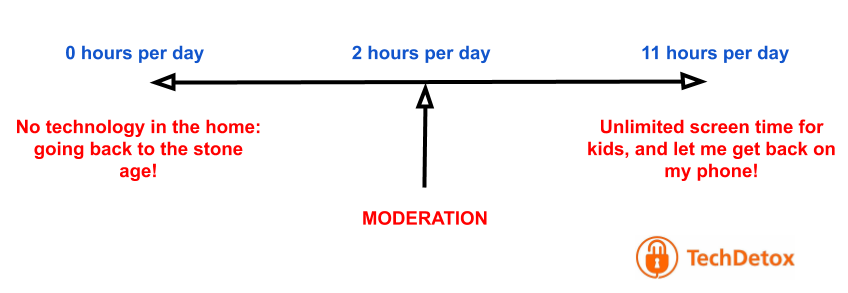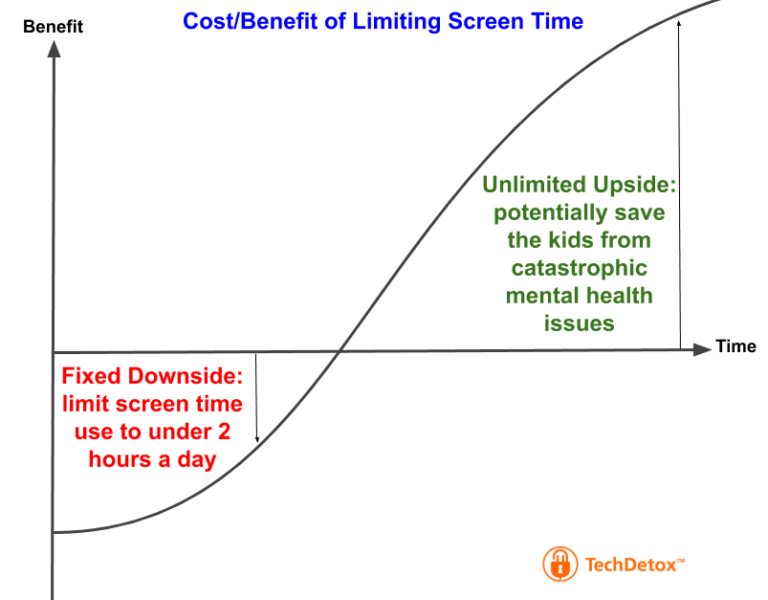
Screen Time Moderation
It’s an unfortunate fact of life that most of the stress that teens experience today originates from their many digital activities. Social comparison, cyberbullying, anxiety, depression, and sheer sense of being overwhelmed trying to keep up correspond directly to the amount of time young people spend on their screens. Yet, parents sometimes go to the extremes when it comes to regulating screen time use: it’s either all or nothing.
Neither abstinence nor binging is the solution.
A much better alternative is moderation. Balance.
As multiple studies have found, smartphone or Internet use of up to an hour or two a day is not linked with mental health issues or unhappiness.
Some teenagers purposely get grounded from their phone. Screenagers blog “See What Teens Do To Reduce Screen Time” reported how some teens and tweens push their family screen time rules to get their phone taken away (for a few days) so they could have a break but could blame their parents for not being able to respond to friends. This is rare but is a clever way for them to save face while getting much needed digital detox to regain their balance. As a parent, I would not mind being a bad guy to help them out.
The amount of screen time is not the decision that should be left to kids’ discretion.
Their immature self-control is no match against the power of addictive technology. Now, what to do for older teens and even young adults? Parents are no longer in control – but we can encourage our children to do the right thing when it comes to digital balance.
For those who feel that two hours per day may be too ambitious, behavioral scientists recommend starting small. Start building smaller digital detox routines, so the system does not go into total shock, and gradually building up to more ambitious tech detox goals:
- Digital curfew: no media half an hour before bed? An hour? Maybe even two? Do not touch the phone before morning coffee? Before breakfast? Before morning workout? Maybe even no media before morning meditation?
- Tech-free sanctuaries: Family dinner? Bedroom (definitely!)? Time reserved for homework? Maybe eventually tech-free social gatherings?
- Batching: group digital activities together: like checking social media or email twice a day instead of every five minutes.
- Digital Sabbath: an intentional period of several to 24 hours without media.
- Digital Sabbatical: a few days to a few weeks UNPLUGGED?
This could become a new endurance sport – who knows?
No More FOMO
I once talked to the mom of a middle school girl, who made a pact with her parents to stay off social media until 18. The girl arrives at school on Monday morning feeling rested and refreshed. She is confronted by her friends, all worked up about the latest gossip: “Don’t you know what happened between so-and-so over the weekend?!” No, she says, I missed all the drama and I am all the better for it.
By the way, she doesn’t feel like a social outcast, her friends do not exclude her from face-to-face communication. What they also tell her is that they are a little jealous of her peace of mind.
But no, they are not willing to give up their cell phones.
They would rather be stressed out than miss out.
I thought – somebody needs to coin the term that would be the opposite of FOMO. It turns out the opposite of FOMO exists!
It is called JOMO – The Joy of Missing Out.
It’s contentment. It’s gratitude for what is already present in your life, not fear about what’s missing.
A contributor to Quora whose credentials include 80+ years of using the English language, suggests that FTSP (Forget The Smart Phone) should be the opposite of FOMO.
Unplug From “Being Informed”
To protect young minds from the stress induced by information overload, I would suggest the practice that originates from philosophy: selective ignorance. News of natural disasters, epidemics, genocide, suicides, and mass shootings are broadcasted because they carry the shock value.
Shock attracts attention to the screens that report these news – which in today’s “attention economy” translates to money.
Much of social media business model is built on the same principle – magnify what is the most negative and appalling in human nature. It keeps the users “engaged”. Also makes them depressed, but the platforms do not care about wellbeing – only the bottom line.
Do teens really need to be informed about horrors they cannot do anything about? What is that going to accomplish – except anxiety and despair?
The only result of “being informed” is being traumatized – which is what we as parents are trying to protect them from.
To prove the point, here is what the American Psychological Association recommends to do in the aftermath of trauma:
- Create a safe space, away from unwanted attention and media
- Lead them away from the site of violence and destruction, or any continued danger
- If they show signs of intense grief, stay with them, provide support
- Help them feel more in control.
So, as much as it’s in your power, steer them away from the stressful content on the screens. Stressing about all the troubles in the world is just that – stressing out and feeling helpless.
Disturbing news is on every day – turn it off.
Other people’s bad behavior on social media is not in their control either – encourage them to ignore the toxicity, or block it altogether.
Instead, let children concentrate only on what they can control. Have them pay attention to their academic work, relationships with good friends and family, activities they enjoy.
Ignore the rest.
If the price of “being informed” is anxiety, it’s not worth it.
External Forms of Protection
It’s a losing strategy to try to rely on self control against addictive technology that has done everything to make sure that the phone never leaves your teen’s hands. It is always there to unload all the stress of the world into their vulnerable immature brain, 24/7. Control of digital media needs to become external like drug control. The problem is – it’s against the interests of the digital media industry, so without a lot of pressure from society and governments it’s unlikely to happen.
Technology that is intentionally designed to be addictive has succeeded beyond expectations.
Humans of all ages have been hacked, and younger humans had digital addiction hard-wired into their brain.
They are called “digital natives”, and the phone is basically a part of their body.
Fortunately, there is enough push back from society that the creators of digital media not only build addictive features into their products – but also ways to turn them off. The Center for Humane Technology pioneers the effort for Humane Tech design. There are a number of ways to mitigate the toxic effects of too much screen time: turn off notifications, remove social media apps from the phone, charge the phone outside the bedroom.
Simple digital wellbeing strategies that can have a big positive impact: it’s a matter of lifestyle design.
Ultimately, the family needs to build good digital habits together. Teens need their parents’ help to help protect their wellbeing from digital overload.
Agree on the family screen time rules, lead by example, and be the person you you want your son or daughter to become.
Create some breathing room. Unplug.




